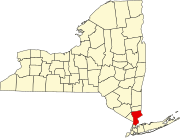Banksville, New York
Banksville is a hamlet in the town of North Castle, Westchester County, New York, United States and an area including Stamford and Greenwich, Connecticut.
The village of Banksville was named after the Banks family, who had settled in this area which is now a part of North Castle, NY, Stamford and Greenwich, CT.
In the days prior to being inhabited by its earliest European settlers of the area, Banksville was a fishing and hunting ground for the Native Americans.
[1] The Native American Chief, Myn Myano, named the Mianus River, which flows from North Castle through Greenwich to the Long Island Sound, after himself.
[2] The early days of the area being settled by non-Native Americans had families granted land further out from the burgeoning population as a way of expanding the township of Greenwich.
[3] Prior to the American Revolution, Banksville was a community of independent farmers who were mostly patriots that did not have a strong allegiance to King George III of England.
[4] Banksville had numerous citizens who fought in the American Revolution including Colonel David Hobby,[5] who belonged to the Westchester County Militia.
One of the founders of Banksville, Benoni Platt, was another proud patriot and Captain in the Second Regiment, Westchester County Militia, New York during the American Revolution.
During colonial times, the village of Banksville also included Middle Patent which borders Bedford, NY and Greenwich.
[11] Additionally, in the early days, all of Banksville, Middle Patent up to Bedford Village was a part of the current State of Connecticut.
The boundary line was ultimately settled in about 1731 for which there was a prior disagreement between the colonies of Connecticut and New York, which predated the Revolutionary War.
The stagecoach service, also known as the “Banksville Stage”, lasted from 1861 to about 1900 providing a round trip from the Greenwich Train station to Bedford, New York.
It originally was located in Finch's Country Store to serve the residents of the community especially the younger children and for a local Boy Scout Troop.
The original location moved from Finch's General Store after Curry and Howay were able to get financial backing to construct a new community house solely dedicated for its own use.
[26] One of the people who helped start the BCH, Mr. Herbert Betrand, bought the Old Jensen Farm in 1939, which was originally an apple orchard.
[27] This is the present location of where the BCH is today on Banksville Avenue in Greenwich on the state line border of New York.
The BCH became headquarters for people in both Connecticut and New York to meet together and make a difference in the war effort including doing such tasks as rolling bandages.
During the Revolutionary War, the building that is the present location to the French restaurant, La Cremiere, was home of the Widow Brush.
Prior to St. Timothy's Chapel, there was no convenient way for Catholic families to access church to practice their religion.
Today, St. Timothy's Chapel is a part of St. Michael the Archangel Catholic Church, a few miles south on North Street.
The Middle Patent School was a small building at the corner of Round Hill and Banksville Bedford Road.
[36] With many farms, families with young children were populating the area, so it was decided to build a schoolhouse in order to serve these people.
The weekend prior to every Thanksgiving, the Banksville Fire Department in conjunction with the BCH, hosts the Turkey Jamboree where residents gather for this community event.
